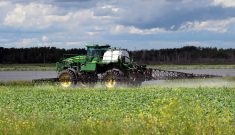VANSCOY, Sask. — Carol McLennan is a graduate of the program.
Ethan Bertholet came through it a decade ago.
And Shauna Chesney is in the program right now.
In an age when employers struggle to retain talent, the success of BASF’s Professional Development Program is evident in the number of staff members who are PDP veterans.
“For me, it has been getting exposure to Western Canada,” said Chesney, an Ontarian, who spoke on a windy day last July on the wide-open plains of central Saskatchewan.
Read Also

New coal mine proposal met with old concerns
A smaller version of the previously rejected Grassy Mountain coal mine project in Crowsnest Pass is back on the table, and the Livingstone Landowners Group continues to voice concerns about the environmental risks.
“I didn’t know what a chickpea looked like before I came out here. Now I have a trial with chickpeas.”
The PDP is a BASF strategy to get talented people into its research and farmer-advising operations, and a way to both develop talent and sift out those who aren’t a good fit.
Recruits, who are generally accepted from advanced university studies, are required to spend two years working in both the research and technical services wings of the company and be able to work far from home.
“Not everybody wants to do two different jobs right off the hop,” said Wayne Barton, BASF Canada’s manager of research and commercial development.
“We’re kind of recruiting for people who are a little more open to being uncomfortable, moving around, doing different jobs in the first couple of years of their career.”
The company doesn’t tell prospective recruits where they’ll be sent, which probably prevents some from applying, but the people it accepts tend to become long-termers.
“It’s been wildly successful,” said Barton.
That is how it worked for Bertholet, who was posted to the Winkler, Man., research farm when he was green.
“I would not have been able to succeed in my role here without that year with Gerald (Martens, the farm manager,)” said Bertholet, a biologist who now runs the Vanscoy research farm.
PDP members who were summer students and interns and applied after graduation often have a good sense of what to expect.
“The pipeline starts with that intern program,” said Barton. “The way we give those interns a project and a chance to really start out is quite unique.”
McLennan said it was initially intimidating to consider joining a global company, but the PDP allowed her to ease into the vast organization.
“For me it was the networking,” she said. “It’s a big company. I got to meet a ton of people.”
Not everybody sticks with BASF but Barton said only a few leave in the years right after completing the PDP, and those who do can be assets at other companies and in other roles.
“Maybe they’ll be a customer some day. Maybe they’ll be a university professor and we’ll get to work with them in that capacity,” said Barton.
“Sometimes we lose people and get them back.”
Agriculture jobs, especially those with big companies, can be hard to fill. Finding qualified people who are willing to move around, take on unfamiliar challenges and live or work in rural areas outside major cities, can be daunting. Retaining good people can also be a struggle.
BASF seems to have shown it can be done.


















